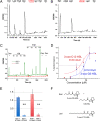Nasal chemosensory cells use bitter taste signaling to detect irritants and bacterial signals
- PMID: 20133764
- PMCID: PMC2840287
- DOI: 10.1073/pnas.0911934107
Nasal chemosensory cells use bitter taste signaling to detect irritants and bacterial signals
Abstract
The upper respiratory tract is continually assaulted with harmful dusts and xenobiotics carried on the incoming airstream. Detection of such irritants by the trigeminal nerve evokes protective reflexes, including sneezing, apnea, and local neurogenic inflammation of the mucosa. Although free intra-epithelial nerve endings can detect certain lipophilic irritants (e.g., mints, ammonia), the epithelium also houses a population of trigeminally innervated solitary chemosensory cells (SCCs) that express T2R bitter taste receptors along with their downstream signaling components. These SCCs have been postulated to enhance the chemoresponsive capabilities of the trigeminal irritant-detection system. Here we show that transduction by the intranasal solitary chemosensory cells is necessary to evoke trigeminally mediated reflex reactions to some irritants including acyl-homoserine lactone bacterial quorum-sensing molecules, which activate the downstream signaling effectors associated with bitter taste transduction. Isolated nasal chemosensory cells respond to the classic bitter ligand denatonium as well as to the bacterial signals by increasing intracellular Ca(2+). Furthermore, these same substances evoke changes in respiration indicative of trigeminal activation. Genetic ablation of either G alpha-gustducin or TrpM5, essential elements of the T2R transduction cascade, eliminates the trigeminal response. Because acyl-homoserine lactones serve as quorum-sensing molecules for gram-negative pathogenic bacteria, detection of these substances by airway chemoreceptors offers a means by which the airway epithelium may trigger an epithelial inflammatory response before the bacteria reach population densities capable of forming destructive biofilms.
Conflict of interest statement
The authors declare no conflict of interest.
Figures




References
-
- Lin W, Ogura T, Margolskee RF, Finger TE, Restrepo D. TRPM5-expressing solitary chemosensory cells respond to odorous irritants. J Neurophysiol. 2008;99:1451–1460. - PubMed
-
- Alarie Y. Irritating properties of airborne materials to the upper respiratory tract. Arch Environ Health. 1966;13:433–449. - PubMed
Publication types
MeSH terms
Substances
Grants and funding
LinkOut - more resources
Full Text Sources
Other Literature Sources
Medical
Molecular Biology Databases
Miscellaneous

